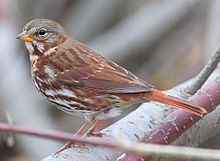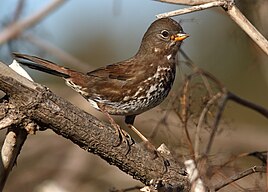Fox sparrow
| Fox sparrow | |
|---|---|

| |
| Red fox sparrow (P. i. iliaca), Whitby, Ontario | |
| Scientific classification | |
| Domain: | Eukaryota |
| Kingdom: | Animalia |
| Phylum: | Chordata |
| Class: | Aves |
| Order: | Passeriformes |
| Family: | Passerellidae |
| Genus: | Passerella Swainson, 1837 |
| Species: | P. iliaca |
| Binomial name | |
| Passerella iliaca (Merrem, 1786) | |

| |
| Breeding ranges of the four fox sparrow groups | |
The fox sparrow (Passerella iliaca) is a large New World sparrow. It is the only member of the genus Passerella, although some authors split the species into four (see below).
Taxonomy

More specific information regarding plumage is available in the accounts for the various taxa.
- Red fox sparrow, P. i. iliaca (Merrem, 1786) – this taxon breeds in the taiga of Canada and Alaska and winters in central and eastern North America. This is the brightest colored group.
- Sooty fox sparrow, P. i. unalaschcensis (Gmelin, JF, 1789) – this taxon breeds along the Pacific coast of North America from the Aleutian Islands south to northwestern Washington, and winters from southeastern Alaska south to northern Baja California. It is browner and darker than the red fox sparrow.
- Slate-colored fox sparrow, P. i. schistacea Baird, SF, 1858 – this taxon breeds in interior western North America and winters to the south and west. It has a gray head and mantle, brown wings, brown breast streaks, and a russet tail.
- Thick-billed fox sparrow, P. i. megarhyncha Baird, SF, 1858 – this taxon is mostly restricted to California and Oregon. This group is similar in coloration to the slate-colored fox sparrow, but features a particularly thick bill, as its name suggests.
Description
Adults are among the largest sparrows, heavily spotted and streaked underneath. All feature a messy central breast spot though it is less noticeable on the thick billed and slate-colored varieties. Plumage varies markedly from one group to another.
Measurements[2]:
- Length: 5.9–7.5 in (15–19 cm)
- Weight: 0.9–1.6 oz (26–44 g)
- Wingspan: 10.5–11.4 in (26.7–29 cm)
Behavior
Fox sparrows are a generally common bird within their range. They forage by scratching the ground which makes them vulnerable to cats and other predators. Most populations of Fox sparrows migrate north for breeding, however some stable populations exist along the west coast of North America.[3][4]
Diet
They mainly eat seeds and insects, as well as some berries. Coastal fox sparrows may also eat crustaceans.
Reproduction
Fox sparrows nest in wooded areas across northern Canada and western North America from Alaska to California. They nest either in a sheltered location on the ground or low in trees or shrubs. A nest typically contains two to five pale green to greenish white eggs speckled with reddish brown.[5]
Systematics
The review by Zink & Weckstein (2003),[6] which added mtDNA cytochrome b, NADH dehydrogenase subunit 2 and 3, and D-loop sequence, confirmed the four "subspecies groups"[7] of the fox sparrow that were outlined by the initial limited mtDNA haplotype comparison (Zink 1994).[8] These should probably be recognized as separate species, but this was deferred for further analysis of hybridization. Particularly the contact zones between the slate-colored and thick-billed fox sparrows which are only weakly distinct morphologically were of interest; the other groups were found to be distinct far earlier.[9] A further study of the nuclear genome, using microsatellites, showed similar separation between the four groups.[10]
The combined molecular data is unable to resolve the interrelationship of the subspecies groups and of the subspecies in these, but aids in confirming the distinctness of the thick-billed group.[6] Biogeography indicates that the coastal populations were probably isolated during an epoch of glaciation of the Rocky Mountains range, but this is also not very helpful in resolving the remaining problems of within-group diversity, and inter-group relationships.
Major taxonomic authorities currently differ in their treatment of the fox sparrow complex. The IOC World Bird List/Birds of the World: Recommended English Names and the HBW and BirdLife International Illustrated Checklist of the Birds of the World treat each of the four subspecies groups as a separate species, while eBird/The Clements Checklist of Birds of the World and The Howard and Moore Complete Checklist of the Birds of the World currently treat the complex as a single species.[11]
References
- ^ BirdLife International. (2016). "Passerella iliaca". IUCN Red List of Threatened Species. 2016: e.T103779110A94696453. doi:10.2305/IUCN.UK.2016-3.RLTS.T103779110A94696453.en. Retrieved 8 April 2021.
- ^ "Fox Sparrow Identification, All About Birds, Cornell Lab of Ornithology". www.allaboutbirds.org. Retrieved 2020-09-29.
- ^ Swarth, H. W. (1920). "Revision of the avian genus Passerella with specia reference to the distribution and migration of the races in California". University of California Publications in Zoology. 21: 75–224.
- ^ Bell, C. P. (1997). "Leap-frog migration in the Fox Sparrow: minimizing the cost of spring migration". Condor. 99 (2): 470–477. doi:10.2307/1369953. JSTOR 1369953.
- ^ Ehrlich, Paul R.; Dobkin, David S.; Wheye, Darryl (1988). The Birder's Handbook: A Field Guide to the Natural History of North American Birds. New York: Simon and Schuster, Fireside. p. 596. ISBN 0-671-65989-8.
- ^ a b Zink, Robert M.; Weckstein, Jason D. (2003). "Recent evolutionary history of the Fox Sparrows (Genus: Passerella)". Auk. 48 (120(2)): 522–527. doi:10.1642/0004-8038(2003)120[0522:REHOTF]2.0.CO;2. S2CID 85871498.
- ^ Not defined by the ICZN
- ^ Zink, Robert M. (1994). "The Geography of Mitochondrial DNA Variation, Population Structure, hybridization, and Species Limits in the Fox Sparrow (Passerella iliaca)". Evolution. 48 (1): 96–111. doi:10.2307/2410006. JSTOR 2410006. PMID 28567786.
- ^ Swarth, H. W. (1920). "Revision of the avian genus Passerella with special reference to the distribution and migration of the races in California". University of California Publications in Zoology. 21: 75–224.
- ^ Zink (2008). "Microsatellite and mitochondrial dna differentiation in the fox sparrow". The Condor. 110 (3): 482–492. doi:10.1525/cond.2008.8496. S2CID 86360069.
- ^ Lepage, Denis. "Passerella [iliaca, unalaschensis, schistacea or megarhyncha]". Avibase - the world bird database. Retrieved 2017-06-04.
- Gill, Frank; Donsker, David, eds. (2014). IOC World Bird List (v 4.4): Bananaquit, buntings, sparrows & bush tanagers (Report). International Ornithologists’ Union. doi:10.14344/IOC.ML.4.4. Retrieved 16 December 2014.
- Beadle, D.; Rising, J. D. (2002). Sparrows of the United States and Canada. San Diego: Academic Press. ISBN 0-691-11747-0.
- Sibley, David Allen (2000). The Sibley Guide to Birds. New York: Alfred A. Knopf. ISBN 0-679-45122-6.
- Zink, Robert M.; Kessen, A. E. (1999). "Species Limits in the Fox Sparrow". Birding. 31: 508–517.
Further reading
Book
- Weckstein, J. D., D. E. Kroodsma, and R. C. Faucett. (2002). Fox Sparrow (Passerella iliaca). The Birds of North America Online (A. Poole, Ed.). Ithaca: Cornell Laboratory of Ornithology; Retrieved from The Birds of North American Online database
Theses
- Blacquiere JR. M.Sc. (1980). Some aspects of the breeding biology and vocalizations of the fox sparrow, Passerella iliaca, Merrem, in Newfoundland. Memorial University of Newfoundland (Canada), Canada.
- Kessen AE. Ph.D. (2004). Population structure in the fox sparrow: An investigation using microsatellites. University of Minnesota, United States—Minnesota.
- Martin DJ. Ph.D. (1976). STRUCTURE OF SONGS AND ORGANIZATION OF SINGING IN FOX SPARROWS BREEDING IN NORTHERN UTAH AND SOUTHERN IDAHO. Utah State University, United States—Utah.
- Zink RM. Ph.D. (1983). PATTERNS AND EVOLUTIONARY SIGNIFICANCE OF GEOGRAPHIC VARIATION IN THE SCHISTACEA GROUP OF THE FOX SPARROW (PASSERELLA ILIACA) (OREGON, NEVADA, CALIFORNIA). University of California, Berkeley, United States—California.
Articles
- Anon (1968). "Fox Sparrow Very Rare Summer Resident 10-11-65 Swamp Sparrow Rare Winter Visitor 9-11-67 10-29-67 Lykins Gulch Colorado USA". Colorado Field Ornithologist. 4: 13–14.
- Banks, RC (1970). "The Fox Sparrow on the West Slope of the Oregon Cascades". Condor. 72 (3): 369–370. doi:10.2307/1366023. JSTOR 1366023.
- Bell, CP (1997). "Leap-frog migration in the fox sparrow:: Minimizing the cost of spring migration". Condor. 99 (2): 470–477. doi:10.2307/1369953. JSTOR 1369953.
- Blankson ENT & McKernan RL. (1995). Evolutionary and ecological considerations of seven subspecies of the fox sparrow (Passerella iliaca) wintering in California. Strauss, M. vol S, p. Unity in Diversity.
- Burns, KJ (1993). "Geographic variation in ontogeny of the fox sparrow". Condor. 95 (3): 652–661. doi:10.2307/1369608. JSTOR 1369608. S2CID 53062826.
- Burns, KJ; Hackett, SJ (1993). "Nest and nest-site characteristics of a western population of fox sparrow (Passerella iliaca)". Southwestern Naturalist. 38 (3): 277–279. Bibcode:1993SWNat..38..277B. doi:10.2307/3671433. JSTOR 3671433. S2CID 53055485.
- Burns, KJ; Zink, RM (1990). "Temporal and Geographic Homogeneity of Gene Frequencies in the Fox Sparrow Passerella-Iliaca". Auk. 107 (2): 421–425. doi:10.2307/4087632. JSTOR 4087632.
- Christie, DS (1968). "Summer Occurrence of the Fox Sparrow in New-Brunswick Canada Passerella-Iliaca". Canadian Field-Naturalist. 82 (1). doi:10.5962/p.342843.
- Hubert, P; Smith, A (1974). "Possible Fox Sparrow Nesting in Minnesota". Loon. 46 (1).
- Jewer, OD; Threlfall, W (1978). "Parasites of the Fox Sparrow Passerella-Iliaca and Northern Waterthrush Seiurus-Noveboracensis in Newfoundland Canada". Proceedings of the Helminthological Society of Washington. 45 (2): 270–272.
- Johnson, JW; Johnson, L (1972). "Fox Sparrow Observations in the Huron Area". South Dakota Bird Notes. 24: 4.
- Martin, DJ (1977). "Songs of the Fox Sparrow Part 1 Structure of Song and Its Comparison with Song in Other Emberizidae". Condor. 79 (2): 209–221. doi:10.2307/1367164. JSTOR 1367164.
- Martin, DJ (1979). "Songs of the Fox Sparrow Passerella-Iliaca 2. Intra Population and Inter Population Variation". Condor. 81 (2): 173–184. doi:10.2307/1367286. JSTOR 1367286.
- Martin, DJ (1980). "Response by Male Fox Sparrows Passerella-Iliaca to Broadcast of Particular Con Specific Songs". Wilson Bulletin. 92 (1): 21–32.
- Martin, DJ (1990). "Songs of the Fox Sparrow 3. Ordering of song". Wilson Bulletin. 102 (4): 655–671.
- Martin, DJ; Naugler, CT; Smith, PC (1993). "Song similarity in populations of fox sparrows: A rejection of Naugler's and Smith's conclusions—Comment/reply". The Condor. 95 (4): 1057. doi:10.2307/1369448. JSTOR 1369448.
- Naugler, CT; Smith, PC (1991). "Song Similarity in an Isolated Population of Fox Sparrows Passerella-Iliaca". Condor. 93 (4): 1001–1003. doi:10.2307/3247734. JSTOR 3247734.
- Peyton, LJ (1971). "Geographical Variation of Fox Sparrow Songs in Alaska". Proceedings of the Alaska Science Conference. 22 (39).
- Robert, MZ; Jason, DW (2003). "Recent evolutionary history of the Fox Sparrows (Genus: Passerella)". The Auk. 120 (2): 522. doi:10.1642/0004-8038(2003)120[0522:REHOTF]2.0.CO;2. S2CID 85871498.
- Ryan, AG (1974). "An Incubation Period and a Nestling Period for the Fox Sparrow". Canadian Field-Naturalist. 88 (2): 230–231. doi:10.5962/p.344381.
- Schmid, U (1979). "2 Rare Guest Birds on North Sea Island of Scharhoern West Germany Fox Sparrow Passerella-Iliaca and Scarlet Grosbeak Carpodacus-Erythrinus". Vogelkundliche Berichte aus Niedersachsen. 11 (2): 45–46.
- Threlfall, W; Blacquiere, JR (1982). "Breeding Biology of the Fox Sparrow Passerella-Iliaca in Newfoundland Canada". Journal of Field Ornithology. 53 (3): 235–239.
- Webster, JD (1975). "The Fox Sparrow in Southwestern Yukon and Adjacent Areas". Condor. 77 (2): 215–216. doi:10.2307/1365798. JSTOR 1365798.
- Webster, JD (1983). "Passerella-Iliaca-Chilcatensis New-Subspecies a Fox Sparrow from Alaska USA". Proceedings of the Biological Society of Washington. 96 (4): 664–668.
- Zink, RM (1983). "Evolutionary and Systematic Significance of Temporal Variation in the Fox Sparrow Passerella-Iliaca". Systematic Zoology. 32 (3): 223–238. doi:10.2307/2413443. JSTOR 2413443.
- Zink, RM (2008). "Microsatellite and Mitochondrial DNA Differentiation in the Fox Sparrow". The Condor. 110 (3): 482–492. doi:10.1525/cond.2008.8496. S2CID 86360069.
External links
- Fox sparrow - Passerella iliaca - USGS Patuxent Bird Identification InfoCenter
- Fox sparrow species account - Cornell Lab of Ornithology
- "Red fox sparrow media". Internet Bird Collection.
- Fox sparrow photo gallery at VIREO (Drexel University)


